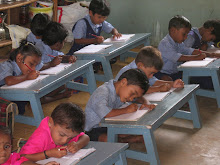I saw a program on TV which relayed the latest in camel racing from Dubai. Yes, the desert kingdom has had some pangs of conscience. After years of using young boys as camel riders for racing, they have succumbed to the criticism of their fellow human beings and have started using robots. That’s right. All the camels are mounted by robots, only half the body is required, fixed on to the saddle. But these robots also have whips in their hands. And there is a speaker installed in the robot to convey messages to the camel.
A road runs parallel to the camels’ track. In this road, Arab men (the women are busy in the Gucci and Louis Vuitton shops, I think) race down in their sport utility vehicles (SUV’s), driven by their chauffeurs, while constantly making clicking and other noises that the camels like to hear to egg them on to faster movement, into their hand held devices. I presume they also regularly click the button that will make the robot whip the camel! Welcome to the new high tech world of camel racing.
Now, this gives me an idea. An entrepreneur can organize betting on which of the cars would win the parallel race in which they are racing!
But we need to see where else we can take this idea. For instance, the whole race can be conducted from the couch. All you need are a few cameras placed along the track, and the Arab camel masters can sit comfortably in their couch and race their camels, with all the same accoutrements they now use. That would also be eco-friendly since they will not be racing their gas guzzling vehicles.
Let’s face it. We are punching buttons all the time. We start at an early age. Have you seen the little children with a Play Station or Game Boy in their hands? Have you noticed the bulging muscles on those little fingers?!
Punching buttons can be fun. Look at people in the casinos. A few years ago, they would have to pull down a lever to turn the drums and see whether all the bananas lined up to make them a winner. Now, there is a lever on the side if you want to exercise one arm (like the tennis player does), but pressing a button on the machine will also get those wheels turning. There is a channel on my TV that relays poker games on a 24 hour basis. Unfortunately various state and federal laws prevent betting on line, on tv, etc. But that will soon change since people need something to do when they lose their jobs, and they are losing it in large numbers. Why not start showing those slot machines on TV and one should be able to turn those drums with the remote, seated on one’s couch. Another button on the remote should darken the room, and create the requisite casino ambiance. And this will be eco friendly. We do not need to travel to those casinos.
Oh, I almost forgot to mention. The Georgia Institute of Technology in the US is designing battlefield robots. Various versions of robots are already in existence. They are sort of boxes, (or vehicles), that are used for mine detection, and so on. And there are un-manned planes, called drones, that can be sent flying deep into enemy territory to bomb a target. Some of these drones sent to bomb in Pakistan and Afghanistan are operated out of command posts in Nevada in the US heartland. But the new robots will be different. They will resemble humans (remember the movie Robot Cop? That was a good one!) and the professor who is designing them has promised that the software will make the robot soldier ethical. That is, it will not allow the heat of the moment to cloud its judgment and misbehave. No chances of walking into an Iraqi house and mistakenly killing the whole family.
Let’s get back to that couch. We are seeing a future where the US soldier will each be assigned a robot and can sit in his couch at home with his family around him and search for weapons of mass destruction around the world, or replace nasty dictators ethically with the help of a remote. Family friendly wars.
Here are my stock picks for the future. Invest in couches and remotes.
தாய் மண்ணே வணக்கம்
6 years ago
